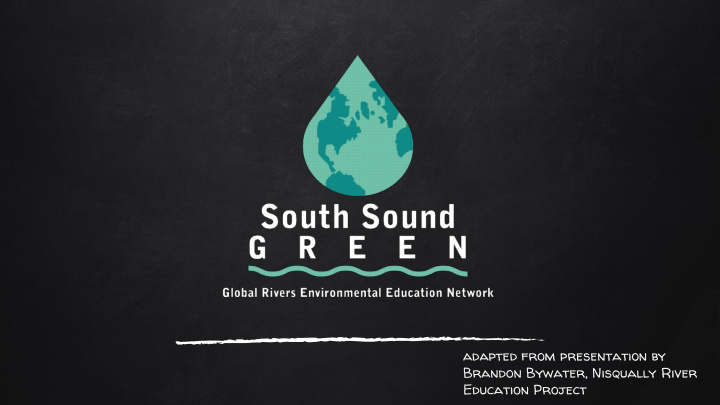



adapted from presentation by Brandon Bywater, Nisqually River Education Project
Water Quality Monitoring All life on EARTH depends on WATER.
75 % of the Earth’s surface is covered in WATER!
surface water
The Water Cycle Evaporation Condensation (cools and forms clouds) Precipitation (rain & snow) Runoff Infiltration (groundwater)
What’s the point?!?! Water is a LIMITED RESOURCE.
Watershed: What is it? All of the land that drains into a common body of water. Includes: Living things Non-living things Cultures Traditions
Puget Sound Watershed
Thurston County Watersheds
Totten Watershed
ELD Watershed
Deschutes Watershed
Henderson Watershed
History of Squaxin People Image: http://squaxinisland.org/
SALMON are an important piece of our ecosystems, economy, culture and traditions.
Point vs. Non-point Pollution
POINT SOURCE POLLUTION Can be managed and controlled. Easier to form strategies for cleanup. Often managed by EPA.
NON-POINT SOURCE POLLUTION Harder to identify and isolate. Often has millions of contributors.
Water Quality Testing ✘ Dissolved Oxygen ✘ Temperature ✘ pH ✘ Biochemical Oxygen Demand ✘ Nitrates ✘ Turbidity ✘ Total Solids ✘ Fecal Coliform
1. Dissolved Oxygen How much OXYGEN is in the water.
Animals in the water breathe in oxygen Acceptabl Optimal Poor Fatal e 3.5 - 6 Salmon >9 mg/L 7-8 mg/L <3.5 mg/L mg/L
2. Temperature How HOT or COLD the water is. (measured in degrees Celsius)
Cold water holds MORE dissolved oxygen. warm water cold water = = dead fish healthy and happy fish
3. pH How ACIDIC or BASIC the water is.
“ 7 ” is NEUTRAL on the acid-Base scale. 1-6 Acidic 8-14 Basic
Changes in pH affect aquatic organisms. Acceptabl Optimal Fatal e Salmon 7 - 8 6.5 - 8 < 6.5
4. Biochemical Oxygen Demand How much OXYGEN is being used in the water by BACTERIA.
Day 1 (D.O.) - Day 5 (D.O.) Optimal value: < 6.0 mg/L When there is more bacteria in water, it uses up more oxygen. This leaves less available oxygen for other animals in the water.
5. Nitrates How many nutrients are in the water.
Too many NITRATES feed bacteria. Nitrogen from fertilizers. Rain events wash nitrogen into streams. More nitrogen creates more food for bacteria.
Making connections Less Dissolved More More Oxygen Nitrogen Bacteria For Animals
6. Turbidity How CLEAR or CLOUDY the water is.
How does TURBIDITY affect animals in the water? Increases temperature Decreases visibility (predators can’t find prey & prey can’t avoid predators) Affects breathing Smothers salmon eggs
7. Total Solids The weight of CLOUDINESS in the WATER.
Optimal value of Total Solids = < 25 mg/L
8. Fecal Coliform How much bacteria is in the water. (from the feces of warm blooded animals)
Fecal coliform lives in the digestive tract of: Farm animals Human beings Wildlife Pets
Human health concerns affected by fecal coliform bacteria in water. Most common form of fecal coliform bacteria is : E. coli This can make people very sick.
Scenarios that may Affect Water Quality
Scenario #1 INCREASES: WHITE WATER Turbidity Total Solids Dissolved Oxygen
INCREASES: DECREASES: Dissolved Nitrates Oxygen Scenario #2 Turbidity FERTILIZER Total Solids
DECREASES: Scenario #3 TRASH Dissolved Oxygen INCREASES: Fecal Coliform pH Temperature Turbidity (leaching)
Nitrates INCREASES: Fecal Coliform Turbidity Total Solids DECREASES: Dissolved Oxygen
INCREASES: point Turbidity Total Solids or Temperature non-point Fecal Coliform Nitrates pH Scenario #5 CITIES DECREASES: Dissolved Oxygen
INCREASES: Dissolved Oxygen Scenario #6 HEALTHY RIPARIAN ZONE DECREASES: Temperature Turbidity Total Solids
Recommend
More recommend